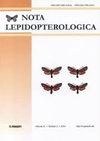Bionomics and host plants of the invasive Cydia interscindana (Möschler, 1866) (Lepidoptera, Tortricidae), an emerging pest in the Carpathian Lowlands
IF 0.7
4区 农林科学
Q4 ENTOMOLOGY
引用次数: 0
Abstract
Cydia interscindana (Möschler, 1866) has spread through several European countries in the past few years, becoming an invasive pest of ornamental trees. It was collected in Hungary for the first time in a pheromone trap set for Cydia pomonella (Linnaeus, 1758) in 2014. Here we discuss its recent distribution in Hungary based on intensive sampling between 2018 and 2020, which showed the dispersal of the pest by humans. Two formerly unknown host plants are also recorded. The damage caused by the larvae, the external morphology of the adult male, larva, pupa (described for the first time) and pupal exuviae are presented. We also analyse DNA barcodes, identifying this pest for the first time via DNA sequencing of immature stages. Introduction Cydia interscindana is native in the Mediterranean region, where it was described by Möschler in 1866 from Andalusia. It is distributed in Mediterranean countries including Portugal (Corley 2004), Spain (Férriz et al. 2006), France (Lévêque et al. 2017) and Italy (Minelli 1995). Later the species was recorded in the British Isles (Knill-Jones 2020), Belgium (De Prins 2016), Switzerland (Swisslepteam 2010), Slovakia (Pastorális et al. 2018) and Russia (Caucasus; Schurov et al. 2017). In Hungary, Cydia interscindana adults were caught by a sticky delta pheromone trap (CSALOMON RAG type) for Cydia pomonella (Linnaeus 1758) in 2014 during a study on swarming dynamics of the latter pest in Budapest. This provided the first record of the species in the Carpathian basin (Szabóky 2014; Takács and Szabóky 2015). In the Mediterranean region larvae feed on Juniperus oxycedrus (L.) (Miller 1990). In Belgium the larva was recorded on Juniperus spp. (Meert et al. 2019). J. oxycedrus is not native in Hungary, but Cupressus × leylandii A.B. Jacks. & Dallim 1926, Platycladus orientalis (L.) Franco 1949 and Chamaecyparis lawsoniana (A. Murray bis) Parl. 1864 are popular evergreens used as ornamental trees both in parks and gardens. In Hungary several pests of these plants have been recorded, all probably introduced with imported plants; in the literature, 11 Lepidoptera, nine Coleoptera and six Hemiptera species have been mentioned already (Csóka and Kovács 1999; Maráczi 2013; Bozsik et al. 2016; Schurov et al. 2017). However, until the end of the 2000s, only Scolytidae (Coleoptera) species caused serious damage (Bozsik and Szőcs 2017). In 2012, an outbreak of the formerly detected (Muskovits 2001) Lamprodila festiva (Linnaeus 1767) (Buprestidae) took place in Budapest (Németh 2012) causing serious damage on Platycladus orientalis and several ornamental gymnosperm species. This outbreak was certainly caused by introduced specimens, that had arrived with trees from the Mediterranean region where this beetle is a well-known pest (Merkl 2016), whose abundance in Hungary increases due to climatic change (Csóka et al. 2018). Based on the available data, in Hungary this beetle pest has also been blamed for all the damage caused on Cupressus, Platycladus and Chamaecyparis trees and management has been carried out only against them. In 2018, a larva of L. festiva, an unidentified caterpillar and a freshly emerged specimen of Cydia interscindana were collected simultaneously from a Leyland cypress in Székesfehérvár (Central Hungary). In that year, similar Lepidoptera larvae were found in three neighbouring villages: Velence, Sukoró and Pákozd. To identify the sampled caterpillar, DNA analysis was undertaken. Additionally, in 2019–2020 a country-wide investigation was carried out to map the distribution and abundance of C. interscindana and gather data on bionomics of this pest in the Carpathian basin.喀尔巴阡低地一种新出现的害虫——入侵的印度小蠊(Möschler,1866)(鳞翅目,小蠊科)的生物学和寄主植物
Cydia interscindana(Möschler,1866)在过去几年中已经在几个欧洲国家传播,成为观赏树木的入侵性害虫。2014年,它首次在匈牙利的一个为绒花Cydia pomonella(林奈,1758)设置的信息素陷阱中被收集。在这里,我们根据2018年至2020年的密集采样,讨论了它在匈牙利的最新分布,这表明了这种害虫被人类传播。还记录了两种以前未知的寄主植物。介绍了幼虫造成的危害,成年雄性、幼虫、蛹(首次描述)和蛹蜕皮的外部形态。我们还分析了DNA条形码,通过对未成熟阶段的DNA测序首次识别出这种害虫。Introduction Cydia interscindana原产于地中海地区,1866年Möschler在安达卢西亚对其进行了描述。分布于地中海国家,包括葡萄牙(Corley 2004)、西班牙(Férriz等人,2006)、法国(Lévêque等人,2017)和意大利(Minelli 1995)。后来,该物种在不列颠群岛(Knill Jones 2020)、比利时(De Prins 2016)、瑞士(Swisslepeam 2010)、斯洛伐克(Pastorális等人,2018)和俄罗斯(高加索;Schurov等人,2017)被记录。在匈牙利,2014年,在布达佩斯进行的一项关于后一种害虫群集动态的研究中,印度洋小蠊成虫被一个针对小蠊(林奈1758)的粘性德尔塔信息素陷阱(CSALOMON RAG型)捕获。这提供了喀尔巴阡山盆地该物种的第一个记录(Szabóky 2014;Takács和Szaböky 2015)。在地中海地区,幼虫以圆柏为食(Miller 1990)。在比利时,Juniperus spp.记录了幼虫(Meert等人,2019)。J.oxcedrus不是匈牙利本地人,而是Cupressus×leylandii A.B.Jacks。&Dallim 1926,Platycladus orientalis(L.)Franco 1949和Chamaecyparis lawsoniana(A.Murray bis)Parl。1864是公园和花园中常用的常青树。在匈牙利,已经记录到这些植物的几种害虫,它们都可能是由进口植物引入的;在文献中,已经提到了11种鳞翅目、9种鞘翅目和6种半翅目物种(Csóka和KováCs 1999;Maráczi 2013;Bozsik等人2016;Schurov等人2017)。然而,直到21世纪末,只有Scolytidae(鞘翅目)物种造成了严重的破坏(Bozsik和Szõcs 2017)。2012年,在布达佩斯(Németh 2012)爆发了以前检测到的(Muscovits 2001)花叶夜蛾(林奈1767)(Buprestidae),对侧柏和几种观赏裸子植物造成了严重破坏。这次疫情的爆发肯定是由引进的标本引起的,这些标本是从地中海地区引进的,这种甲虫是一种著名的害虫(Merkl 2016),由于气候变化,其在匈牙利的数量增加(Csóka等人,2018)。根据现有数据,在匈牙利,这种甲虫害虫也被认为是对柏、侧柏和香柏造成的所有损害的罪魁祸首,并且只对它们进行了管理。2018年,在Székesfehérvár(匈牙利中部)的Leyland柏树上同时采集到了一只L.festiva幼虫、一只身份不明的毛毛虫和一只新出现的Cydia interscindana标本。同年,在邻近的三个村庄:Velence、Sukoró和Pákozd发现了类似的鳞翅目幼虫。为了鉴定采样的毛毛虫,进行了DNA分析。此外,在2019-2020年,在全国范围内进行了一项调查,绘制了C.interscindana的分布和丰度图,并收集了喀尔巴阡盆地这种害虫的生物组学数据。
本文章由计算机程序翻译,如有差异,请以英文原文为准。
求助全文
约1分钟内获得全文
求助全文
来源期刊

Nota Lepidopterologica
Agricultural and Biological Sciences-Insect Science
CiteScore
1.70
自引率
14.30%
发文量
20
审稿时长
14 weeks
期刊介绍:
Nota Lepidopterologica is the scientific, peer-reviewed journal of the Societas Europaea Lepidopterologica (SEL). It publishes original contributions to the study of mainly but not exclusively Palaearctic Lepidoptera, especially on taxonomy, morphology/anatomy, phylogenetics, biogeography, ecology, behaviour, and conservation, but also on any other aspects of lepidopterology.
All articles are published in English, with the possibility of having the summary written in other languages. All submitted manuscripts are subject to peer-review by the leading specialists for the respective topic. The journal is published in open access high-resolution PDF, semantically enriched HTML and machine-readable XML versions.
All papers can be freely copied, downloaded, printed and distributed at no charge. Authors and readers are thus encouraged to post the pdf files of published papers on homepages or elsewhere to expedite distribution. Publication is free for the SEL members and there is no charge for color.
 求助内容:
求助内容: 应助结果提醒方式:
应助结果提醒方式:


